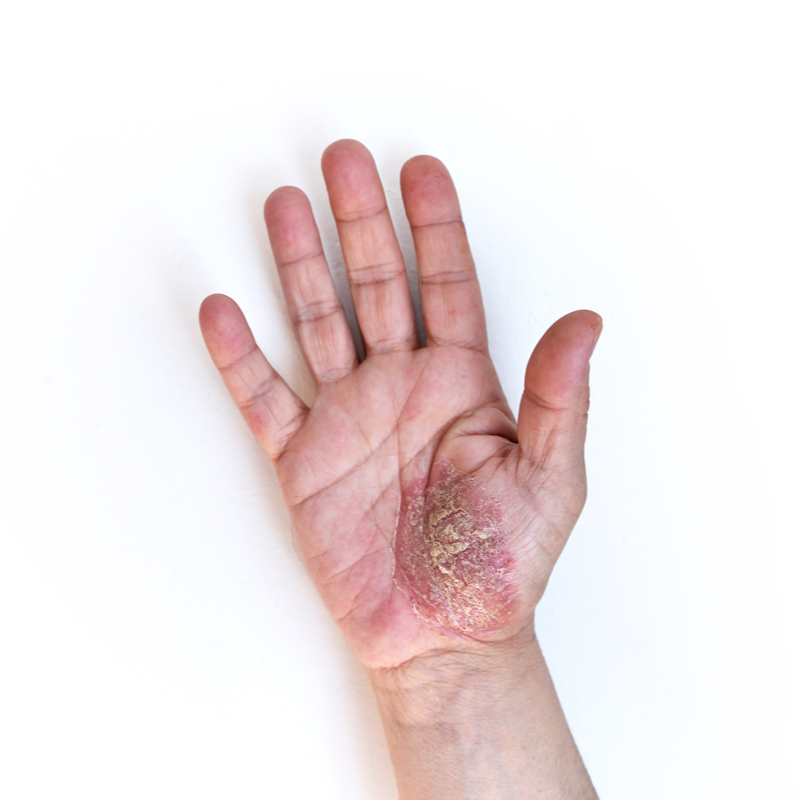
What is Sézary syndrome?
Sézary syndrome is a advanced, rare leukaemic cancer. It belongs to an aggressive form of so-called cutaneous lymphoma. This is a malignant disease that develops from the so-called lymphocytes (cells of the immune system) and affects the skin as well as the blood and in some cases even the lymph nodes. Sézary syndrome can lead to the development of cancer cells in the blood, enlarged lymph nodes and/or extensive lesions or skin rashes.
Sézary syndrome affects people of middle and old age more than average, with men being affected more often than women. The disease increases the risk of developing other cancers or lymphomas. In addition, Sézary syndrome can impair the function of the immune system and thus increase the risk of infection . As long as the disease is diagnosed and treated quickly , it is possible to manage the effects of the disease.
How is Sézary syndrome different from mycosis fungoides?
Some medical professionals believe that Sézary syndrome is a more advanced stage of mycosis fungoides, while other medical professionals consider the two diseases to be separate. However, it can hardly be denied that both Sézary's syndrome and mycosis fungoides in disease stage IV have similar features, which can be described as follows:
- 80 per cent of the body surface has a rash, tumours or lesions.
- There is a high number of Sézary cells in the blood.
- There are cancerous tumours that have spread to the spleen, lymph nodes as well as the liver and/or other organs.
What risk factors favour the development of Sézary syndrome?
According to , the exact causes of Sézary's syndrome are still unknown. . However, it has been observed that some affected people have a human T-cell leukaemia virus that infects the lymphocytes . It is possible that these viruses cause changes in the DNA . However, this does not mean that Sézary syndrome is a hereditary disease. This is because it is not passed on from parents to their children .
What are the symptoms of Sézary syndrome?
Sézary syndrome can cause the following different skin problems:
- dry, scaly and/or itchy skin,
- Skin tumours,
- thickened patches of skin, mainly on the palms of the hands and/or the soles of the feet,
- red rash (erythroderma) that covers most of the body . It is possible that at least 80 percent of the body is affected by this rash.
Sézary syndrome can also cause the following symptoms:
- abnormal nail growth,
- Hair loss (alopecia),
- Outward protrusion of the eyelid (ectropion),
- Swelling due to fluid retention (oedema) - this mainly affects the arms and/or legs,
- swollen lymph nodes,
- enlarged liver and/or spleen,
- Fever,
- unwanted weight loss.
How is Sézary syndrome diagnosed?
Sézary syndrome can be diagnosed by a specialist who specialises in lymphomas . Since Sézary's syndrome is rather rare, a confirmed diagnosis should be made by a haematopathologist or dermatopathologist. The following examinations are performed:
- Biopsy: A tissue sample of the skin, lymph nodes and/or bone marrow is taken to be analysed for signs of cancer.
- Blood test: A CBC and/or peripheral blood smear can be taken to check the number of red blood cells, white blood cells, platelets and haemoglobin.
- Immunophenotyping: describes the collection of a blood or tissue sample that may show cancer markers, which may be present on the cell surface and may indicate a specific type of lymphoma .
- T-cell receptor (TCR) gene rearrangement test: This is a blood or bone marrow test that looks for gene mutations that primarily control T-cell function.
How is Sézary syndrome treated?
Since Sézary syndrome cannot usually be cured, the form of treatment is palliative in nature. This means that the therapy is designed to relieve the symptoms. The following forms of treatment can be used for this purpose:
- Extracorporeal photopheresis (ECP): This involves taking blood from the body and treating the cancer cells with a drug that makes the cells sensitive to light. UV light is used to kill the harmful cancer cells before the blood is returned to the body.
- Immunotherapy or biological therapy: This aims to stimulate the body's immune system to fight the cancer cells from the inside.
- other forms of drug treatment: Corticosteroids can relieve reddened or irritated skin areas and are applied in the form of creams or ointments . Retinoid creams or gels slow down the growth of cancer cells. Histone deacetylase inhibitors can stop the division of tumour cells.
- UV phototherapy (PUVA): After previous use of the drug psoralen, the cancer cells are treated with the so-called UVA phototherapy, which uses ultraviolet light in the A range (UVA) or in the B range (UVB).
- Radiotherapy: this involves exposing the entire surface of the skin to strong doses of radiation.
- Chemotherapy: can be given topically (on the skin) or systemically (throughout the body) by taking tablets.
What is the prognosis for Sézary syndrome?
The 5-year survival rate for Sézary syndrome is just under 24 percent. It is foreseeable that this survival rate will steadily increase due to advances in medical standards and the use of newer and more effective treatments.
